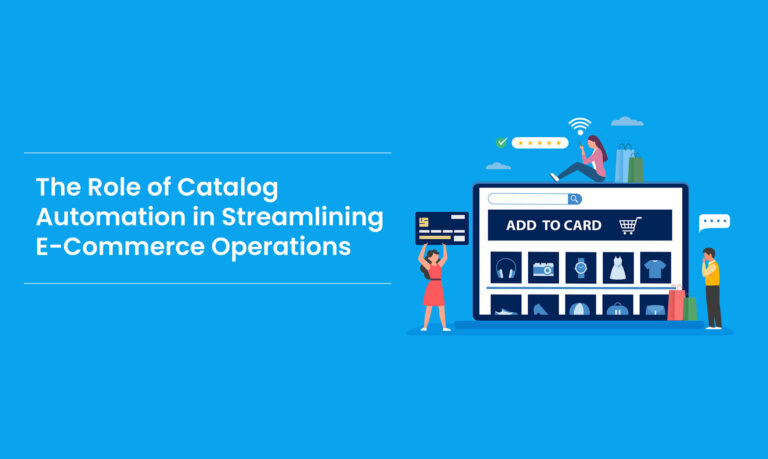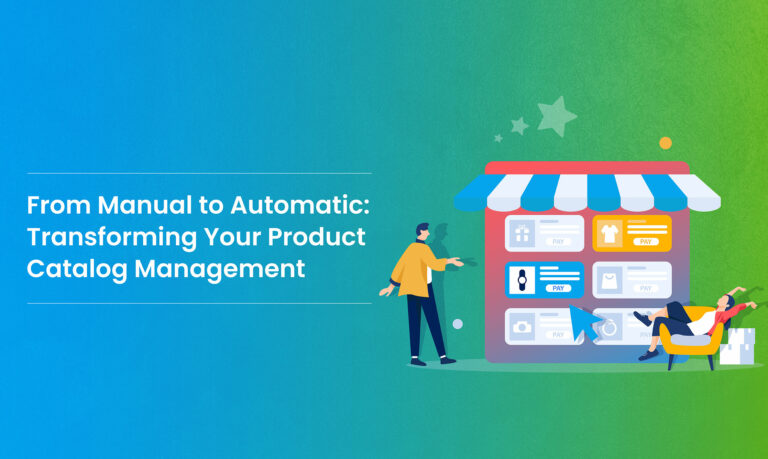Introduction
The way businesses arrange and present their product listings is changing, and cataloging automation is one area where e-commerce businesses may benefit substantially. Automating the creation, upkeep, and organization of product catalogs increases output, decreases error rates, and frees up staff time. Better operational agility overall and faster product introductions are the outcomes of this. Furthermore, automatic categorization guarantees platform consistency, improving client confidence and experience.
Adopting automation for cataloging is not just a practical choice but also a calculated decision for companies looking to grow and remain competitive in the ever-changing e-commerce market. Consider adopting solutions like Rubick.ai for an even more seamless and intelligent catalog management experience.
Streamlining the Product Listing Process for Increased Efficiency and Accuracy
In the quick-moving world of online shopping, being accurate and fast is vital for success. It’s crucial to have a thorough AI data catalog in place.
E-commerce Catalog Automation
Having a strong e-commerce catalog automation system is crucial for making the product listing process smoother. This means using technology to automatically handle tasks like entering data, organizing items, and ensuring accuracy.
Automated Product Listing
Utilize automated tools for creating product listings. This can include batch processing, rule-based automation, and integration with suppliers to reduce manual efforts and minimize errors.
Streamlined Catalog Management
Implement a centralized Product Information Management (PIM) system to streamline catalog management. This ensures a single source of truth for product information, leading to consistency across channels.
Accurate Product Information
Enforce data standardization and implement quality control checks to ensure the accuracy of product information. Automated validation processes can help identify and rectify errors before products go live.
Saving Time and Resources with Automated Updates and Synchronization
In the era of dynamic e-commerce, staying ahead requires not just catalog updates but a seamless integration of automated processes. This encompasses real-time synchronization with suppliers, efficient batch updates, and strategically scheduled audits to ensure the perpetual currency of product information.
Automated Catalog Updates
Implement automated processes for updating the catalog. This includes real-time synchronization with suppliers, automatic batch updates, and scheduled audits to keep product information current.
Synchronized Product Data
Ensure synchronization of product data across various platforms and channels. This minimizes discrepancies and saves time by eliminating the need for manual adjustments.
Time-Saving Catalog Management
Use tools that automate repetitive catalog management tasks, freeing up your team to concentrate on strategic activities instead of spending time on routine updates.
Resource Optimization in E-commerce
Optimize resources by reducing manual intervention. Automated processes lead to resource efficiency, allowing your team to allocate time and efforts to more value-added tasks.
Improving Customer Experience with Consistent and Rich Product Information
Creating an immersive and trustworthy e-commerce environment begins with prioritizing consistency and accuracy. This involves enforcing stringent data standards to build customer confidence, supplemented by compelling product descriptions generated and updated through automated tools.
Enhanced Customer Experience
Consistent product data across all touchpoints contributes to an enhanced customer experience. A unified and accurate catalog ensures that customers receive reliable information, fostering trust.
Consistent Product Data
Enforce data standards to maintain consistency in product information. This consistency builds customer confidence and reduces the likelihood of confusion or dissatisfaction.
Rich Product Descriptions
Enhance product listings with rich and detailed descriptions. Utilize automated tools to generate and update compelling product content, improving the overall quality of the customer experience.
Improved E-commerce Conversions
Consistent and rich product information positively impacts conversions. Customers are more likely to make informed purchasing decisions when presented with accurate and compelling product details.
Better Inventory Management and Stock Control through Automation
Achieving precision in inventory management is paramount for seamless e-commerce operations. Implementing automated systems, from real-time updates and efficient stock control to integrated alerts, guarantees accurate information on product availability and minimizes the risk of order cancellations due to stockouts.
Automated Inventory Management
Implement automated systems for inventory tracking and management. This includes real-time updates, automated reorder triggers, and integration with sales channels to prevent overselling.
Efficient Stock Control
Enhance stock control through automation by establishing rules for stock thresholds, automating restocking processes, and receiving timely alerts for low inventory levels.
Real-Time Inventory Updates for E-commerce Businesses
Ensure that real-time inventory level changes are available on your e-commerce platform. This lowers the possibility of purchase cancellations due to out-of-stock products by guaranteeing clients receive correct information about product availability.
Gaining Competitive Advantage by Staying Ahead of Market Trends with Automated Insights
Staying updated on industry trends is essential in the highly competitive realm of online buying. Companies that examine these shifts and adjust accordingly have a competitive advantage. Automated inventory management ensures that companies can accurately and easily satisfy market needs by adding an extra degree of efficiency.
E-commerce Trends
Understanding the e-commerce landscape is crucial for making informed decisions. Automated insights use advanced tools to analyze extensive data, including customer behavior and purchasing patterns. This helps businesses gain a clear understanding of the constantly changing e-commerce environment.
Real-time Data Processing
Data is processed instantaneously by automatic insights, saving a significant amount of time compared to manual deductive reasoning. Businesses can act quickly, grab opportunities, and steer clear of problems by closely observing and evaluating events as they happen.
Predictive Analytics for Future Trends
Automated insights not only examine the past but also forecast future trends. By identifying patterns in historical data, these systems accurately predict upcoming trends. This foresight helps businesses prepare for customer preferences and industry changes.
Competitive Advantage through Catalog Automation
To stay ahead in online business, you need to be flexible. Using AI catalog management helps keep your product listings always up-to-date, showing what’s popular and what customers want. This flexibility lets you easily add new products and stay in line with what people are looking for.
Personalized Customer Experiences
Understanding market trends extends beyond products to creating a personalized customer experience. Automated insights assist businesses in providing tailored recommendations, marketing, and promotions based on the latest trends. This personalized approach enhances customer satisfaction and loyalty.
Dynamic Pricing Strategies
Competing effectively in e-commerce involves strategic pricing. Automated insights examine competitor pricing, market demands, and other factors to propose the most effective pricing strategies. This adaptable approach assists businesses in staying competitive and maximizing their revenue.
Inventory Optimization
Efficient inventory management is critical for meeting customer demand and avoiding unnecessary costs. Automated insights analyze both historical and real-time data to ensure optimal inventory levels. This ensures that popular products are consistently available, preventing wasteful expenses on slow-moving items.
Responsive Marketing Campaigns
Market trends affect how people shop, and automated insights help businesses adjust their marketing to match. By knowing what’s popular, businesses can create ads and promotions that really connect with customers. This kind of quick response makes marketing efforts more effective.
Adapting to Seasonal Changes
E-commerce goes through ups and downs during the year, and automated insights help businesses get ready. By looking at past data and trends, businesses can change their inventory, marketing plans, and promotions to fit the seasons. This adaptability ensures businesses not only survive but do well in changing market conditions.
Continuous Improvement through Feedback Loops
Automated insights create a loop for getting better all the time. By looking at how well decisions worked out, businesses can adjust their strategies using real-time data. This constant process helps businesses stay flexible and do better as market trends change.
Conclusion
Utilize cataloging automation to transform your e-commerce business and get unmatched accuracy and efficiency. Accept the strategic shift towards competitiveness and scalability by using technologies that provide a smooth and intelligent catalog management experience. These strategies provide improved productivity and customer happiness, from simplifying the product listing process to saving time and money with automatic updates, guaranteeing consistent client experiences, and obtaining a competitive edge through market trend data. Use the power of automated catalog management to seize the chance to optimize, simplify, and prosper in the ever-changing world of e-commerce. Choose Rubick.ai for a smarter, more efficient, and future-ready e-commerce journey.

